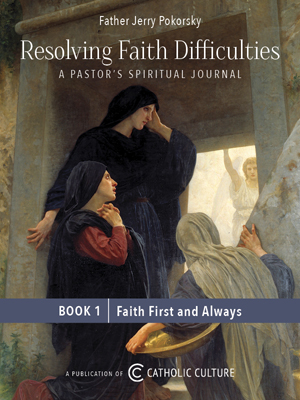Catholic Prayer: Nuptial Blessing
Description:
Rev. Schmiedeler describes the beautiful nuptial blessing for the newly wedded husband and wife, emphasizing its great importance for our times.
Prayer:
One of the greatest sacramentals of the Church is the Nuptial or bridal blessing. It has deep significance and should become more cherished with each remembrance during the years that follow its reception. This solemn blessing is for bride and groom, but especially for the former. The fact that it is incorporated into the Nuptial Mass suggests its importance in the eyes of the Church.
It consists of three meaning prayers. Two of them are recited as the priest halts the Mass for that purpose immediately after the Pater Noster. With the exception of the consecration of the oils on Holy Thursday, no other blessing is so intimately associated with the Canon of the Mass. The third prayer of the blessing is cited over the couple just before the last blessing of the Mass.
The text of this blessing is readily available today in the English language. Hence we shall but briefly indicate the content of the three prayers here.
The first asks God's help for the two who have been united in the institution of marriage which God Himself has founded.
The second draws a detailed picture of what the life of a truly Christian wife should be. For example, it holds up for imitation on her part such holy women as Rachael, Rebecca, and Sarah. Again, it urges that she be adorned with virtue; adhere to faith and the commandments; be faithful to her husband; fortified through strong discipline, grave in demeanor, modest and well taught in heavenly lore. The words of the entire prayer are in sharp contrast to the ideals that stream into the modern home through the voice of the world about us today.
The third prayer of the nuptial blessing is recited, as already noted, just before the last blessing of the Mass, or, in other words, immediately following the Post-communion. The Church chooses this moment, when the sacred bond of marriage has been sealed in the Sacrifice of Christ, and when the newlywed couple has been united in the Communion of Christ's Body, to close her prayer with maternal good wishes from the same source with which she began the wedding Mass, namely the Book of Tobias.
"May the God of Abraham, the God of Isaac, and the God of Jacob," she prays, be with you, "and may He fulfill His blessings in you, that you may see your children's children even to the third and fourth generation, and thereafter may have life everlasting, by the grace of our Lord Jesus Christ, Who with the Father and the Holy Ghost liveth and reigneth forever. Amen."
After this prayer the priest sprinkles the newly married couple with holy water. Next, with head bowed toward the altar, he recites the usual prayer from the Ordinary of the Mass that is known as the Placeat. Following this, he turns toward them, blesses the two, as well as all who have been in attendance at Mass, in the name of the Holy Trinity.
This special nuptial blessing suggests the high esteem in which wedded life is held by the Church. It is the Church's solemn petition to God that the union be holy and richly blessed. Its origin reaches back in one form or other to the earliest Christian centuries. It should be particularly meaningful today because of the low estate to which marriage has fallen. The Rev. Bernard Sause, for instance, writes of it as follows in "Why Catholic Marriage is Different":
"In this blessing and in the lesson it stresses, in wise and humble submission and beautifully worded prayer and sacrifice, the Catholic is in calm possession of the one answer for which others are searching. He has the one counter-influence to a mentality far removed from the sacred and only real nature of Christian marriage. His is a treasure thoroughly to be understood, appreciated, cherished. Its significance is not for the morning of the wedding, only to make the Catholic ceremony different from that of others. It is to regulate married life, to lift it to a plane with heights that merely human effort is incapable of scaling."
Note: This account of the Nuptial Blessing was written in the 1950's and the formula of the blessing may have been altered since that time, although the principles remain the same.
Prayer Source: Your Home, A Church in Miniature by Compiled by The Family Life Bureau in the early 1950s, The Neumann Press, Long Prairie, Minnesota, 1994





